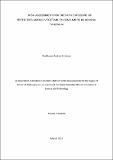| dc.description.abstract | Information on the extent of pesticide residues in vegetables from Tanzania and risk of dietary exposure to these residues among vegetable consumers is limited. This research assessed the risk of dietary exposure of pesticide residues in vegetable farmers and individuals with non-communicable disorders in Arusha. Face-to-face interviews were conducted to assess pesticide application practices. Observations were made to assess effectiveness of vegetable processing practices at household level, in reducing pesticide residues. Two-point 24 hour recalls and food frequency questionnaire techniques were used to determine vegetable consumption. Raw and ready-to-eat vegetables were sampled and analyzed for pesticide residues using Gas Chromatography-Mass Spectroscopy. Dietary exposure to pesticide residues was estimated. The results showed that vegetables were contaminated with organophosphates, pyrethroids organochlorines, carbamates and benzoic acid pesticides. Endosulfan and dieldrin which are banned for use in agriculture in Tanzania were quantified in the vegetables at levels above their respective Maximum Residue Levels. Exposure estimations showed that 18.6% of vegetable farmers are at risk of exposure to organophosphates [Hazard index (HI); 1.19], mainly contributed by dimethoate. Individuals with NCDs are at risk of exposure to organophosphates (HI; 1.12) and organ chlorines (HI; 1.08) mainly attributed to exposure to chlorpyrifos and endosulfan, respectively. Dietary exposures of pesticides are significantly associated with lack of advice from agricultural extension officers (adjusted odds ratio (AOD) = 6.56; P = 0.031), over-dosage of pesticides in vegetables (AOD = 3.751; P = 0.038) and lack of professional training on pesticide application practices (AOD = 3.37; P = 0.043). Washing vegetables in a bowl two or more times with changing the washing water after one use, (χ 2 (1) = 6.56; P = 0.01) or peeling (χ 2 (1) = 6.949; P = 0.008 is significantly associated with low levels of pesticides in ready to eat vegetables. Poor practices in washing of minor ingredients (tomato, carrot, sweet pepper and onions) such as washing by water that was previously used to wash the major ingredients has significant association with the occurrence of pesticide residues in vegetables (χ 2 (1) = 25.55; P = 0.001. Based on the findings of this study it is necessary to ensure continuous monitoring of pesticide residues in vegetables and training growers on good agricultural practices and best practices on vegetable handling at household level. | en_US |

